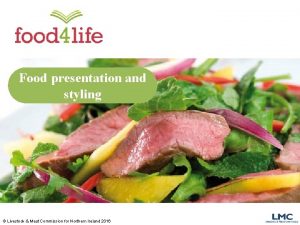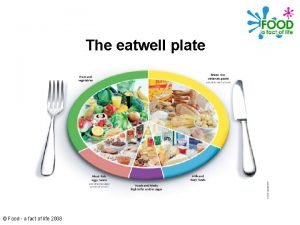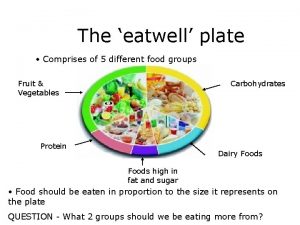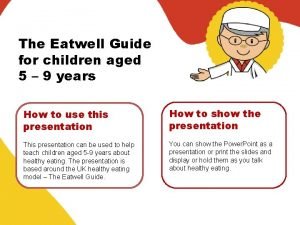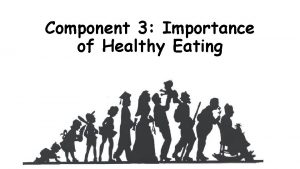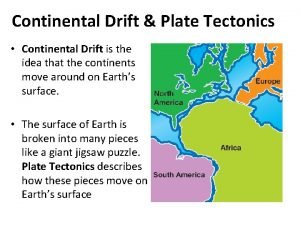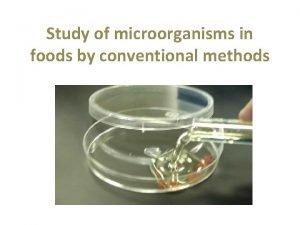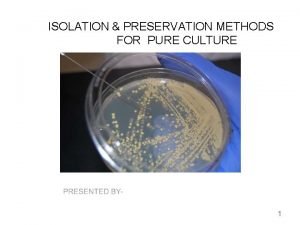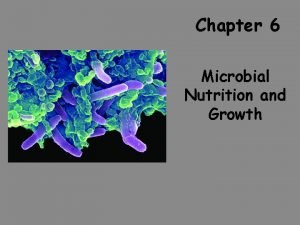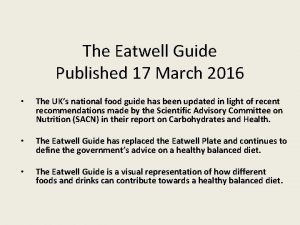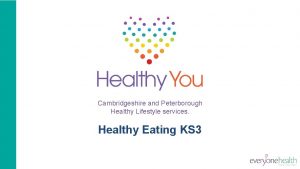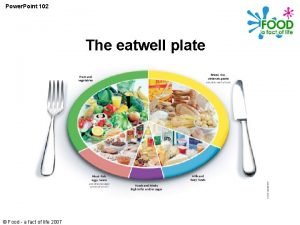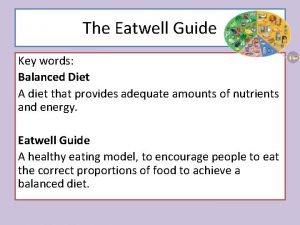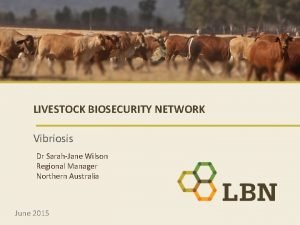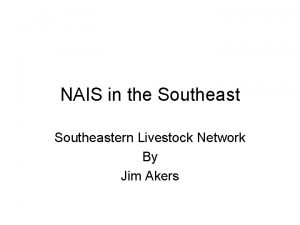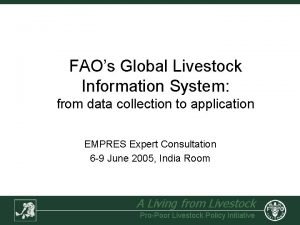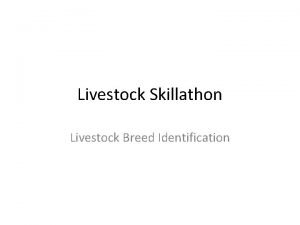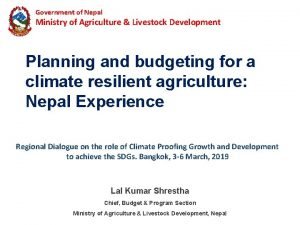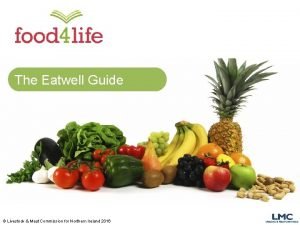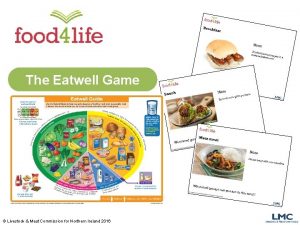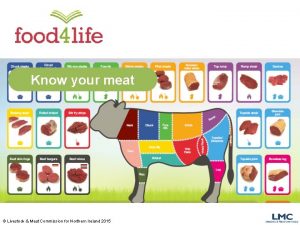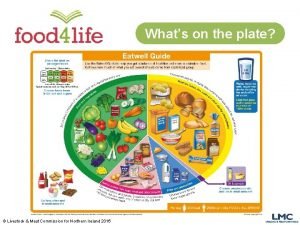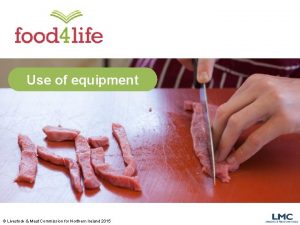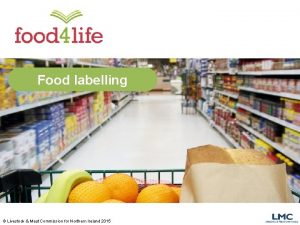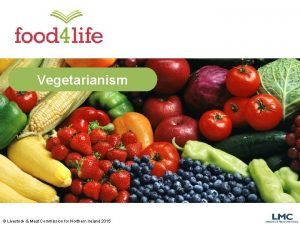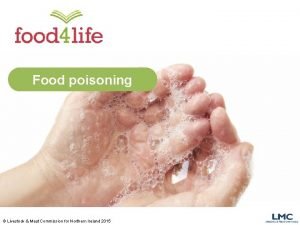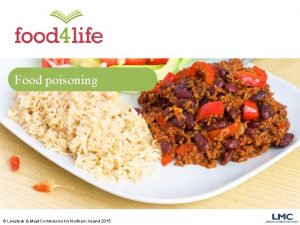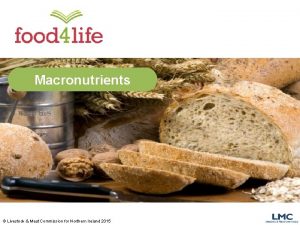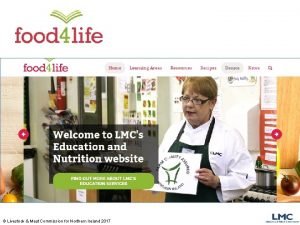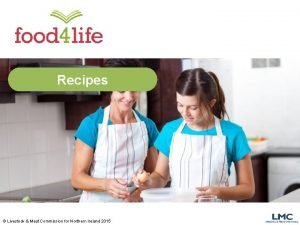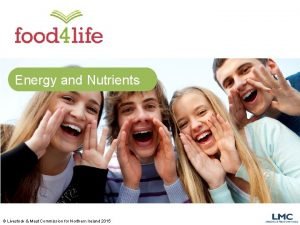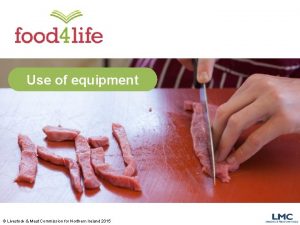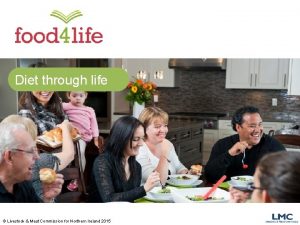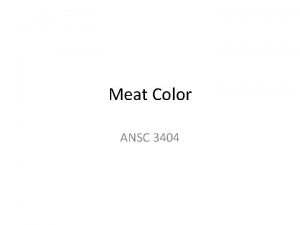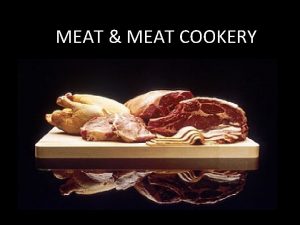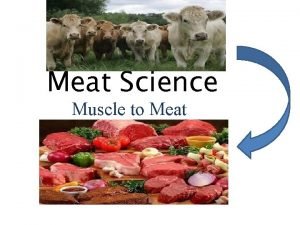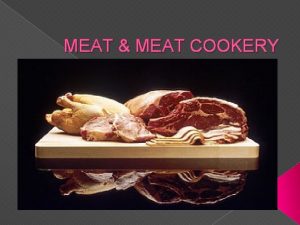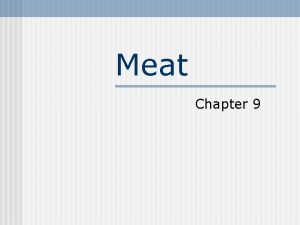The eatwell plate Livestock Meat Commission for Northern
























- Slides: 24

The eatwell plate © Livestock & Meat Commission for Northern Ireland 2015

Learning Objectives The key learning objectives for this section are that you will: • Recognise and describe The eatwell plate; • Identify each of the five groups of The eatwell plate and provide examples of food and/or drink in each group. © Livestock & Meat Commission for Northern Ireland 2015

A healthy varied diet Apart from breastmilk as a food for babies, no single food contains all the essential nutrients the body needs to be healthy and function efficiently. The nutritional value of a person's diet depends on the overall balance of foods that is eaten over a period of time, as well as on the needs of the individual. A healthy diet is likely to include a variety of foods, from each of the main food groups, as this allows us to get all the nutrients that we need. All food and drinks can be part of a healthy diet but it is important to get the balance right! © Livestock & Meat Commission for Northern Ireland 2015

© Livestock & Meat Commission for Northern Ireland 2015

The eatwell plate The UK healthy eating model is called the eatwell plate. The eatwell plate is a guide to the proportion of foods we should eat from each food group to have a healthy, varied diet. The eatwell plate is appropriate for most healthy people over two years of age including: vegetarians; people of all ethnic origins; people who are a healthy weight for their height as well as those who are overweight; and pregnant women. Children between the ages of two and five years can make a gradual transition towards the type of diet shown in the eatwell plate. People under medical supervision or with special dietary requirements may want to check with their doctor/dietitian if the eatwell plate applies to them. © Livestock & Meat Commission for Northern Ireland 2015

The eatwell plate is made up of five food groups: • Fruit and vegetables; • Bread, rice, potatoes, pasta and other starchy foods; • Milk and dairy foods; • Meat, fish, eggs, beans and other non-dairy sources of protein; • Foods and drinks high in fat and/or sugar. © Livestock & Meat Commission for Northern Ireland 2015

The eatwell plate Look at the size of each of the food groups. What does this tell you about the proportions of each group? © Livestock & Meat Commission for Northern Ireland 2015

The eatwell plate Most of what we eat should come from the two biggest food groups: • Bread, rice, potatoes, pasta and other starchy foods; • Fruit and vegetables. We should consume smaller amounts from the Milk and dairy foods group and the Meat, fish, eggs, beans and other non-dairy sources of protein group. Only a small amount from the foods and drinks high in fat and/or sugar group should be included. © Livestock & Meat Commission for Northern Ireland 2015

The eatwell plate Even within a single group, different foods provide a different selection of nutrients, so variety is important to ensure we get the many nutrients we need to be healthy. It is not necessary to follow the model rigidly at every single meal; instead aim to get the balance between the different food groups right; over the course of a day or even a week. © Livestock & Meat Commission for Northern Ireland 2015

Fruit and vegetables should make up approximately 1/3 of our daily food intake. Try to include some at every meal and for snacks. Aim to eat at least five portions of fruit and vegetables each day. Choose a wide variety of fruits and vegetables as they all have different proportions of vitamins and minerals that help to keep us healthy. Different fruit and vegetables contain: vitamin C, vitamin A, folate, fibre, potassium and magnesium. © Livestock & Meat Commission for Northern Ireland 2015

What counts towards your 5 a day? • Fresh, frozen, dried, canned and juiced types; • Fruit and vegetables cooked in dishes such as soups, stews or pasta dishes, or present in ready meals and shop bought sauces, soups and puddings; • A glass (150 ml) of unsweetened 100% fruit or vegetable juice counts as a maximum of one portion a day; • Smoothies containing at least 80 g of pulped fruit and/or vegetables and 150 ml juice can count as up to a maximum of two portions per day; • Beans and pulses count as a maximum of one portion a day no matter how many you eat as they don't contain the same mixture of vitamins, minerals and other nutrients as fruit and vegetables. © Livestock & Meat Commission for Northern Ireland 2015

What is a portion? One adult portion of fruit or vegetables is 80 g. For example: • One medium sized piece of fruit such as a banana, apple, pear, orange or nectarine; • Two or more small fruits such as plums, satsumas, kiwi fruit or apricots; • A large handful of berries, cherries or grapes; • One heaped tablespoon of dried fruit such as raisins, cranberries or sultanas (you only need 30 g of dried fruit because the portion size is based on the weight of the fresh fruit); • One dessert bowl of salad; • Three heaped tablespoons of vegetables or pulses (beans, lentils, chick peas). © Livestock & Meat Commission for Northern Ireland 2015

Do you eat 5 a day? With just a little planning, we can make sure we get our 5 A DAY. Think about the following meal occasions, how could you include a portion of fruit or vegetables? Breakfast Dried or fresh fruit with cereal, glass of juice Mid morning snack Piece of fruit Lunch Beans on toast or a bowl of salad Mid afternoon snack Vegetable sticks with hummus Dinner Mixed vegetables and canned fruit in juice © Livestock & Meat Commission for Northern Ireland 2015

Bread, rice, potatoes, pasta and other starchy foods Approximately one third of our total daily food intake should be from this group. This group also includes breakfast cereals, cous, yam, quinoa, cassava and other types of starchy foods. Try to include them at every meal by basing your meals on starchy foods such as potatoes, breads, pasta, rice, noodles or cereals. © Livestock & Meat Commission for Northern Ireland 2015

Bread, rice, potatoes, pasta and other starchy foods Choose high fibre or wholegrain varieties as much as possible as these usually contain more fibre, vitamins and minerals than refined versions. This group can provides carbohydrate, fibre, B vitamins, iron, calcium and folate. © Livestock & Meat Commission for Northern Ireland 2015

Bread, rice, potatoes, pasta and other starchy foods What examples can you think of? Breakfast © Livestock & Meat Commission for Northern Ireland 2015 Lunch Dinner

Milk and dairy foods A moderate amount of these foods is needed in the diet. We should have some milk and dairy food such as cheese, yoghurt and milk every day. Try to use lower fat versions such as skimmed, 1% fat or semi skimmed milks and reduced fat cheese products. Butter, eggs and cream are in other food groups, can you think why? This group provides protein, calcium, iodine, vitamin B 12 and vitamin B 2 (riboflavin). © Livestock & Meat Commission for Northern Ireland 2015

Meat, fish, eggs, beans and other non-dairy sources of protein A moderate amount of these foods is needed in the diet. Try to eat some food from this group every day and aim for at least two portions of fish a week, including a portion of oily fish. This group provides a range of nutrients including protein, vitamin D, vitamin B 12, zinc and omega-3 fatty acids. This group also includes nuts, seeds, beans and pulses, tofu and mycoprotein. © Livestock & Meat Commission for Northern Ireland 2015

Foods high in fat and/or sugar It is important to have some fat in your diet, but you don’t need to eat any of the food in the ‘foods and drinks high in fat/and or sugar’ group as part of a healthy diet. Foods containing a lot of fat are high in energy. Foods such as cakes, pastries, biscuits, chocolate, crisps, fried foods and non-diet fizzy drinks should be considered as treats and only eaten occasionally. For oils, spreads, low-fat spreads and butters, use sparingly, especially if eaten every day. © Livestock & Meat Commission for Northern Ireland 2015

Foods high in fat and/or sugar Sugar adds flavour and sweetness to foods, but frequent consumption of sugar-containing foods and drinks is associated with an increased risk of tooth decay especially in those with poor dental hygiene. © Livestock & Meat Commission for Northern Ireland 2015

Salt does not appear on the eatwell plate. Eating too much salt is associated with an increased risk of developing high blood pressure. People with high blood pressure are more likely to develop heart disease or have a stroke. Most of our salt intake comes from processed foods rather than salt added during cooking or at the table, so use food labels to help you reduce salt intake. Adults and children over 11 should eat no more than 6 g of salt a day. Younger children should have even less. © Livestock & Meat Commission for Northern Ireland 2015

Composite dishes A lot of the dishes and meals we eat are made up of foods from more than one group of The eatwell plate. These are called composite dishes. What examples can you think of? © Livestock & Meat Commission for Northern Ireland 2015

Composite foods Suggest which food groups should be added to each recipe to make a balanced meal. Creamy peppered beef Beef, Stout and Mushroom pie www. food 4 life. org. uk - recipes © Livestock & Meat Commission for Northern Ireland 2015 Thai red beef curry

Acknowledgement For further information, go to: www. food 4 life. org. uk © LMC 2015 © Livestock & Meat Commission for Northern Ireland 2015
 Livestock meat commission
Livestock meat commission Foodafact of life
Foodafact of life Eatwell plate
Eatwell plate Eatwell guide kids
Eatwell guide kids Eatwell guide
Eatwell guide Northern territory electoral commission
Northern territory electoral commission Fresh meat in market
Fresh meat in market Marie earns an 8 commission for selling appliances
Marie earns an 8 commission for selling appliances Defects of curriculum
Defects of curriculum 7 lithospheric plates
7 lithospheric plates Pour plate method steps
Pour plate method steps Picture of alfred wegener
Picture of alfred wegener Isolation and preservation method for pure culture
Isolation and preservation method for pure culture Streak plate method
Streak plate method Eatwell guide 2016
Eatwell guide 2016 Eatwell guide quiz
Eatwell guide quiz Eatwell plat
Eatwell plat The eatwell challenge
The eatwell challenge British nutrition foundation eatwell guide
British nutrition foundation eatwell guide Eatwell guide
Eatwell guide Livestock biosecurity network
Livestock biosecurity network Livestock network
Livestock network Livestock information system
Livestock information system Livestock breed identification sheep
Livestock breed identification sheep Ministry of agriculture and livestock development nepal
Ministry of agriculture and livestock development nepal
